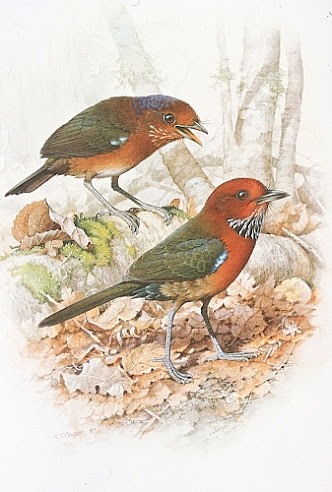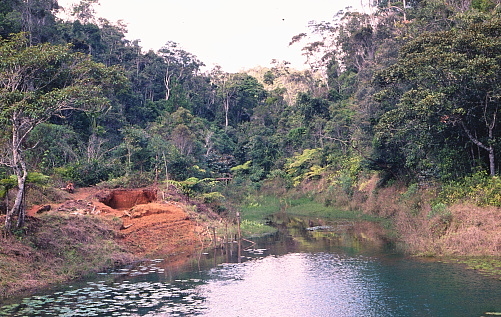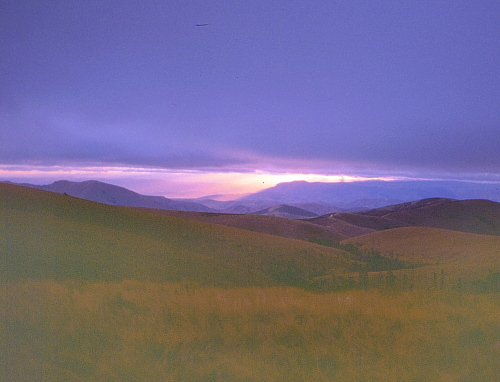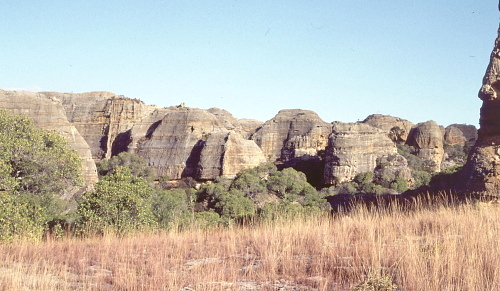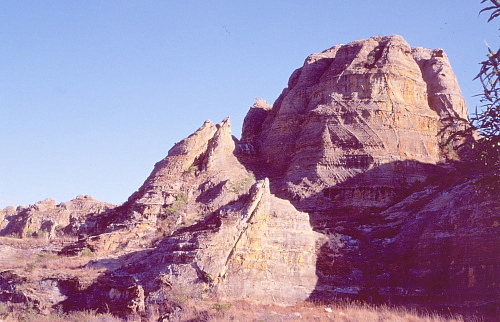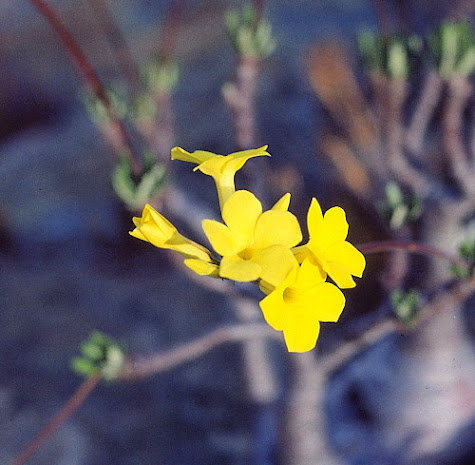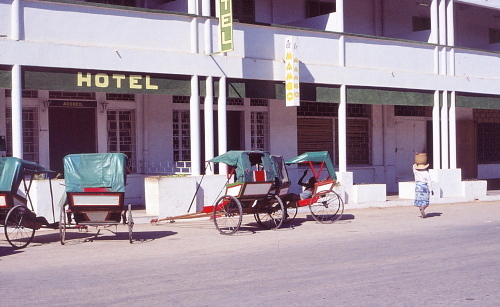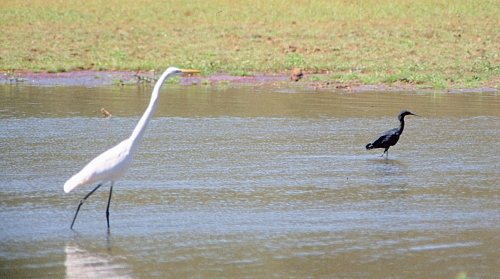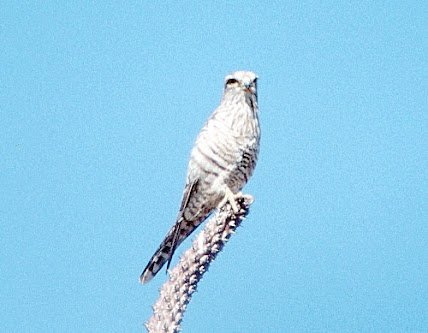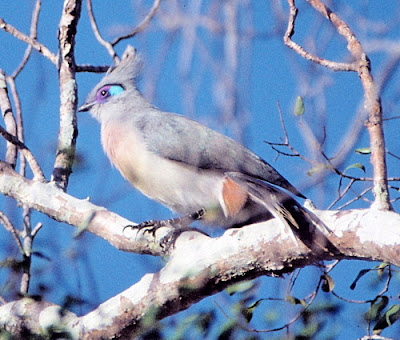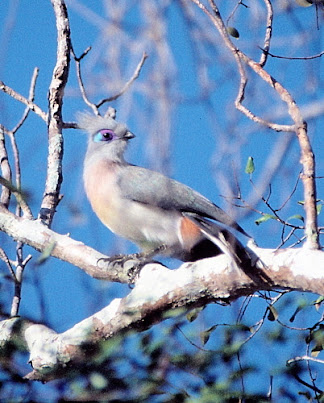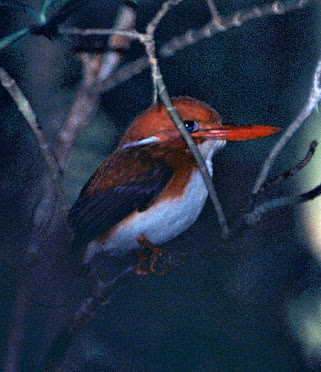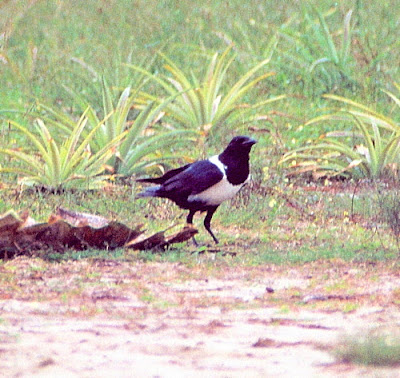MADAGASCAR ITINERARY
Land of Endemics, Ground-Rollers and Lemurs.
Following plates by W.T.Cooper
Short Legged Ground-Roller
Rufous-headed Ground-Roller
Scaly Ground Roller
Pitta-like Ground-Roller
Long-tailed Ground-Roller
The following photographs were taken by myself, unless another photographer is listed in brackets, and I have also used some photographs taken by my son David Cooper who visited Madagascar the following year.
2nd August Departed London Heathrow to Moscow with Richard Fairbank and Nick Preston and then onto Seychelles International Airport for 1 hour stop. Arrived Antananarivo (Tana), where we met up with Barry Stilup and arranged with a local tour company our itinary and a car with driver. Late afternoon, departed for drive to Perinet Andasibe Forest Station, arriving there in the dark.
3rd August All day birding at the Andasibe Forest Station.

The lodge at Perinet where we were staying overnight.
Andasibe Forest Station.
Visit to the Andasibe Forest Station.
Viewpoint at the Andasibe Forest Station.
View taken inside the Andasibe Forest Station.
Tree Ferns at Andasibe Forest Station.
4th August All day Maromiza Forest with a late afternoon visit to the nearby Maromiza Marsh.
5th August Early morning visit to Maromiza Marsh and then drove back to Tana to catch internal flight to Maronasetra and booked into a local hotel with chalets. Birded in the hotel gardens and along the river at Maronasetra. Arranged for a early morning boat for the following day.
Tana internal airport (rather basic) on our way to Maronasetra.
Maronasetra High Street.
Maronasetra Lodge, where we were staying one night.
Orchids in the Lodge's gardens.
6th August 2 hour boat trip from Maronasetra to Anbanizana and then spent the rest of the day birding in the Forest Reserve. Heavy rain all afternoon and evening. Camped overnight.
Anbanizana Forest Reserve.
Boat Trip from Maronasetra to Anbabizana Forest Station.
View taken on the climb up at Anbanizana, shortly after this it rained
for the rest of our stay here.
7th August All day Anbanizana Forest Reserve, heavy rain all day made birding very difficult, also had damaged my left big toe which swelled up to twice its normal size and became very painful to walk. This toe lasted virtually the entire holiday and made life very difficult.
8th August Early morning Anbanizana with the return boat trip back to Maronassetra.
9th August Morning birding around Maronasetra and then internal flight back to Tana.
10th August Long drive from Tana, over the High Plateau to the Ampijoroa Forest Station arriving around mid-day. Nice fine dry weather and we visited a local marshy area some 17kms north of Ampijoroa. Camped for 3 nights at the Ampijoroa Forest.
Sunrise over the High Plateau.
11th August All day birding at the Ampijoroa Forest Station.
All day birding at the Ampijoroa Forest Station.
The dry forest reserve at Ampijoroa.
Turtle Sanctuary for endangered Turtles at Ampijoroa.
Above 2 pictures taken at the Marshy area near Ampijoroa.
12th August All day birding around the Ampijoroa Forest Station.
13th August Early morning birding Ampijoroa and then drove back over the High Plateau to Tana.

Birding at Ampijoroa Forest Station, typical early Autumn sunshine.
14th August Drove from Tana to Ranomafana National Park where we booked into a chalet.
15th August Roadside birding at Ranomafana with heavy rain all day and visited Vohiparara Marsh.

Above two views of Ranomafana National Park.
16th August All day birding in the Ranomafana National Forest, again rain all day.
River in full flow, with rain all day at Ranomafana.
An attractive dripping bank at Ranomafana National Park.
An attractive dripping bank with wild flowers at Ranomafana National Park.
17th August: Birding at Vohiparara Marsh.
Another visit to Ranomafana National Park and making the most of the dry weather.
20th August: Early morning birding on heathland and lake some 9kms west of Vohiparara with afternoon drive to Ranohira.
Vohiparara Heathlands good site for the Reunion Harrier.
The long drive to Ranohira
Lorry off the road, seems like it has been there a few days looking
at the tent on the left hand side.
We had to make a detour.
We continue with the drive to the sandstone site.
Our first views of the sandstone rocky outcrops, which is our next birding site.
After the long drive, we arrived at Ranohira where we will be staying overnight.
Our 5 star luxury accommodation .
21st August Early morning birding at Oasis and then drove to the nearby Zombitsy Forest where we stayed until dark and then drove to Tulear, and booked into a hotel.
Dawn at Ranohira before setting off to the Oasis.
Our early morning drive out to the Oasis.
Passing through one of the local villages en-route.
Pass the above area on the drive to the Oasis.
Arriving at the Oasis.
Now where is the Benson's Rock Thrush, which we are hoping to find.
Baobab tree in flower, but still looking for the Rock Thrush.
Beautiful Baobab Tree in flower, at the oasis.
Leaving the Oasis behind, as we had obtained some good views of the Rock Thrush.
Arriving at our Hotel in Tulear, a larger town than what we expected.
22nd August Drove from Tulear to Mora Mora and birded rest of the day in the Spiny Forest.
The drive out to Mora Mora, passing through a number of small local villages.
Passing another small local village.
Passing a nice beach on the drive.

23rd August All day birding with local guides in the Spiny Forest with a visit to nearby salt pans.
Four views above of the The Spiny Forest.
La Mangrove Hotel and birding in the surrounding areas.
25th August to 26th August Birding around La Mangrove Hotel with long walk along the coastal footpath.
Here comes our taxi.
Difficult site for birding.
Lets hope its not dinner for tonight.
27th August Return boat trip out to Nosy Ve Island and the sand dunes at Anakao.
Five Views taken on Nosy Ve Island.
Local fishing boat off Nosy Ve.
28th August All day around the La Mangrove Hotel area & coastal footpath.
Richard paying the bill.
29th August Visited the Tulear Airport Pool and then caught internal flight to Tana.
30th August Day visit to Perinet Andasibe Forest Station with local guide.
31st August Return flight back from Tana to London Heathrow, again stopping at Seychelles Airport.
Systematic Bird List.
Madagascar Little Grebe - Tachybaptus pelzelnii
Endemic
A single bird, seen very well, on the lake at Perinet on the 3rd. Considered Vulnerable by Birdlife Int. (2000).
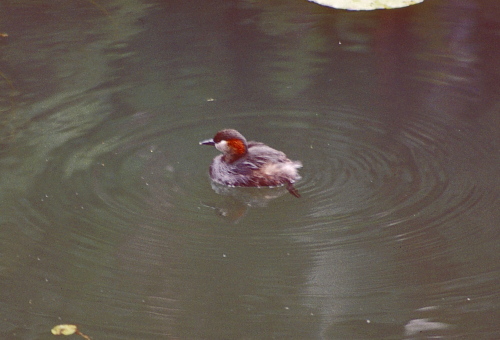.jpg)
Madagascar Little Grebe at Perinet (Taken by D.Cooper).
White Tailed Tropicbird – Phaethon lepturus
A real bonus as we un-expectedly stopped-off at Seychelles International Airport on the flights to and from Madagascar. Fifty were seen on the outward stop-off on the 2nd but only 5 were seen on the return flight on the 31st. They were best seen on the cliff face directly behind the Airport Terminal, but also odd birds were seen flying high over the runway.
Red Tailed Tropicbird – Phaethon rubricauda
Fifteen of these exciting birds were seen on their breeding grounds on Nosy Ve Island on the 27th.

Young Red-tailed Tropicbird.
Red-tailed Tropicbirds on Nosy Ve.
Long Tailed (Reed) Cormorant – Phalacrocorax africanus
Only seen on the river at Maronasetra, with 1 on the 5th, 30 from the boat on the 6th and 1 on the 8th.
African Darter – Anhinga rufa vulsini
Just one of the endemic subspecies vulsini was seen on the lake at Ampijoroa on the 12th.
Black Crowned Night Heron – Nycticorax nycticorax
Four seen on the 5th, flying over the river at Maronasetra, with 8 on the 8th and 1 on the 9th.
Squacco Heron – Ardeola ralloides
Recorded on five dates, with a maximum of 25 on the marsh north of Ampijoroa on the 10th.
Squacco Heron on the marsh near Ampijoroa.
Cattle Egret - Bubulcus ibis
Recorded on 15 dates, with a maximum of 60 on the 13th.
Green Backed Heron – Butorides striatus rutenbergi
Recorded on 14 dates but never more than 3 on a day. Seen daily on the mud from La Mangrove Hotel.
Green Backed Heron at La Mangrove.
Black (Heron) Egret - Egretta ardesiaca
Small numbers recorded on 8 dates, with a daily maximum of 10.
Whats going on, perhaps I will learn something new here!!

Black Heron at Ampijoroa Lake.
Dimorphic Egret – Egretta dimorpha
Only recorded on 7 dates and chiefly from La Mangrove area. Both white and black morphs were seen, but the only blacks seen were at the coast. Daily maximum of 10 on the 25th and 27th.
Both colour phases of the Dimorphic Egrets at La Mangrove.
Dimorphic Egret over Nosy Ve.
Great-White Egret - Egretta alba
Recorded in small numbers on 13 dates with a daily maximum of 8 on the 5th.
Great White Egret at Ampijoroa Lake.
Purple Heron - Ardea purpurea madagascariensis
Singles recorded on 7 dates with 6 on the 10th on the marsh north of Ampijoroa.
Grey Heron – Ardea cinerea firasa
One seen on the 10th at the marsh north of Ampijoroa and up to 4 seen on the mud at La Mangrove on the 5 dates we spent there.
Humblot’s Heron – Ardea humbloti
Endemic
This large Heron was only seen on the mud at La Mangrove on 4 dates but never more than 2 on a day. Considered Vulnerable by Birdlife Int. (2000).
Humbolt,s Heron with Dimorphic Egret at La Manrove.
Humbolt's Heron at La Mangrove.
Hamerkop - Scopus umbretta bannermani
Just 2 singles seen from the road when driving on the 13th and the 20th.
Glossy Ibis – Plegadis falcinellus
A flock of 30 flew high over Ampijoroa on the 13th.
Madagascar Crested Ibis – Lophotibis cristata urschi
Endemic
Seen well on two dates at Ampijoroa with 4 on the 11th, and 2 on the 12th.
Poor record shot of Madagascar Crested Ibis disappearing into the dry forests at Ampijoroa.
White Faced Whistling Duck - Dendrocygna viduata
Seen on 3 dates at Ampijoroa with a maximum of 52 on the 12th.
White Faced Whistling Ducks at Ampijoroa.
African Pygmy Goose – Nettapus auritus
This delightful goose was only seen on 2 dates, with 25 on a marsh on the drive to Ampijoroa and on the marsh to the north of Ampijoroa on the 10th, with 10 on the 13th on the same marsh on the return trip.
Pygmy Geese on marshy area near the Ampijoroa.
Meller's Duck - Anas melleri
Endemic
Just two seen on the 5th, flying over the river at Maronasetra.
Considered Endangered by Birdlife Int. (2000).
Red Billed Teal – Anas erythrorhyncha
Four seen on the marsh close to Ampijoroa on the 10th with a single bird flushed from Vohiparara marsh on the 15th.
Hottentot Teal – Anas hottentota
Ten seen on the marsh north of Ampijoroa on the 10th with 3 on the Tulea Airport Pool on the 29th.
Madagascar Cuckoo Falcon – Aviceda madagascariensis
Endemic
Singles seen on the 16th and 17th near the suspension bridge across the river at Ranomafana. On the 16th, it was sat in a tree drying after heavy rains.
Yellow Billed (Black) Kite – Milvus (migrans) aegyptius parasitus
Recorded on 9 dates often when driving with a daily maximum of 20 on the 10th.
Madagascar Fish Eagle – Haliaeetus vociferoides
Endemic
A pair of these huge magnificent raptors were breeding around the lake at Ampijoroa and had at least one young in the nest. We saw them on 3 days whilst we were here.
Considered Critical by Birdlife Int. (2000).
Madagascar Harrier Hawk – Polyboroides radiatus
Endemic
Three seen on the 10th and 11th and 1 on the 12th at Ampijoroa. Three on the 21st at the Oasis and 1 on the 23rd along the coast at Mora Mora.
Madagascar Harrier Hawk at Ampijoroa.
Reunion Harrier – Circus maillardi macrosceles
Regional Endemic
A superb male was found on heath-land 9kms west of Vohiparara on the 20th and gave good prolonged views.
Considered Endangered by Birdlife Int. (2000).
Male Reunion Harrier over the Vohiparara Heathlands.
Henst’s Goshawk – Accipiter henstii
Endemic
A single bird (with others heard in the forest) was seen from the look-out at Ranomafana on the 18th. Another bird, seen flying over the heath-land 9kms west of Vohiparara, on the 20th.
Madagascar Sparrowhawk – Accipiter madagascariensis
Endemic
One seen sat in a tree at the entrance to Ranomafana on the 18th, and two seen well at Perinet on the 30th. They were initially identified as Madagascar Sparrowhawks, but after research they may very well have been Frances Sparrowhawks.
Male Madagascar Sparrowhawk at Perin.
Frances’s Sparrowhawk – Accipiter francesii
Regional Endemic
Two singles identified, but also see above Madagascar Sparrowhawk. The first on the 4th sat in a tree at Perinet, and the second on the 18th at Ranomafana.
Adult male Madagascar Buzzard – Buteo brachypterus
Endemic
Recorded in small numbers of 12 dates with a daily maximum of 6 on the 19th
Madagascar Buzzard over the Spiny Forest.
Madagascar Kestrel - Falco newtoni
Regional Endemic
Recorded on 20 dates with a daily maximum of 25 on the 20th. Both pale and dark phases seen with the dark morph considered the commonest.
Madagascar Kestrel at La Mangrove.
Banded Kestrel - Falco zoniventris
Endemic
A pair gave close, stunning views on the edge of the Spiny Forest at Mora Mora on the 22nd.
Banded Kestrel at Mora Mora.
Madagascar Partridge - Margaroperdix madagascarensis
Endemic
A pair found on the ground on the edge of the heath land 9kms west of Vohiparara on the 20th.
White Breasted Mesite – Mesitornis variegata
Endemic
A party of five were found skulking in the dry forest at Ampijoroa on the 11th, and another five were seen behind the lake on the 12th. Superb!!
Considered Vulnerable by Birdlife Int (2000).
White Breasted Mesite at Ampijoroa.
Brown Mesite – Mesitornis unicolor
Endemic
After much searching, a pair were located in the rain forest at Ranomafana on the 18th. They did not give themselves away easily, although good views were obtained in the end.
Considered Vulnerable by Birdlife Int. (2000).
.jpg)
Brown Mesite at Ranomanfana (Taken by David Cooper)
Subdesert Mesite – Mesitornis benschi
Endemic
Two were found on the 22nd and the 24th in the spiny forest at Mora Mora. Amazing behaviour, when disturbed they would fly up in to a tree and freeze, one did so for up to half an hour before flying off fast with a whirl of wings.
Considered Vulnerable by Birdlife Int. (2000).
Subdesert Mesites in the Spiny Forest.
Madagascar Buttonquail - Turnix nigricollis
Endemic
Recorded on 7 dates with a daily maximum of 4 on the 11th on a forest trail at Ampijoroa.
Madagascar Flufftail – Sarothrura insularis
Endemic
A single bird seen from down to 3 feet in a middle of a bush and proved to be one of the highlights of the trip. It was close to the entrance of Ranomafana on the 18th. Others were heard calling here and also at Perinet.
Madagascar Wood Rail – Canirallus kioloides
Endemic
Two showed well in the forest at Ranomafana on the 17th, with others heard calling here and at Perinet.
White Throated Rail – Dryolimnas cuvieri
Regional Endemic
Two of these large striking rails were seen well at dusk in a marshy area by the lake at Ampijoroa on the 11th.
White Throated Rail taken at dusk by the lake at Ampijoroa.
Common Moorhen - Gallinula chloropus pyrrhorhoa
A total of 6 seen on 4 dates.
Madagascar Jacana – Actophilornis albinucha
Endemic
Six seen, including immatures, on the marsh 17kms north of Ampijoroa on the 10th.
Madagascar Jacana on Ampijoroa Marsh.
Black Winged Stilt – Himantopus himantopus
Seen around the lake at Ampijoroa with up to 6 on a day and 8 on the Tulear Airport Pool on the 29th.
Kittlitz’s Plover – Charadrius pecuarius
Seen at the Ampijoroa Lake with 9 on the 11th, 6 on the 12th. Eight were present at the salt pans at Mora Mora on the 23rd, with 10 on the 29th at Tulear Airport Pool.
Kittlitz's Plover at the salt pans at Mora Mora.
Madagascar Plover - Charadrius thoracicus
Endemic
A pair performed exceptionally well on the salt pans at Mora Mora on the 23rd, allowing very good views.
Madagascar Plovers at the Salt Pans at Mora Mora.
Three Banded Plover – Charadrius tricollaris
Two seen at the Ampijoroa lake on the 11th with 4 on the 12th. A pair present on a small pool at Mora Mora on the 24th.
White Fronted Plover – Charadrius marginatus tenellus
One seen on a sandbank from the boat as we left Maronasetra on the 6th, with 5 on the beach at Mora Mora on the 23rd and 3 close to Anakao on the 27th.
White Fronted Plover on the beach at Mora Mora
Grey Plover - Pluvialis squatarola
Seen only on the mud from La Mangrove with 10 on the 25th and 6 on the 26th.
Madagascar Snipe – Gallinago macrodactyla
Endemic
Our only sighting was of a single bird flushed several times from Vohiparara marsh on the 15th.
Whimbrel – Numenius phareopus
Recorded from coastal sites on 5 dates, with a maximum of 50 on the mud at La Mangrove on the 25th.
Marsh Sandpiper – Tringa stagnatilis
A single bird present on the Tulear Airport pool on the 29th.
Greenshank – Tringa nebularia
Recorded on seven dates, with a maximum of 30 on the 25th at La Mangrove.
Common Sandpiper – Actitis hypoleucos
Small numbers recorded on six dates.
Curlew Sandpiper – Calidris ferruginea
Four seen on the Tulear Airport pool on the 29th.
Kelp Gull – Larus dominicanus
An immature bird flew over La Mangrove on the 26th.
Caspian Tern – Sterna caspia
Seen only in the La Mangrove area with 1 on the 25th, and 26th and 3 on the 27th.
Greater Crested Tern – Sterna bergii enigma
One seen from the boat trip from Anbanizana on the 8th. Seen daily at La Mangrove with a maximum of 20 on the 27th.
Lesser Crested Tern – Sterna bengalensis
Five seen roosting on a sandbank with Crested Terns on Nosy Ve Island on the 11th.
Whiskered Tern – Chlidonias hybridus sclateri
Ten seen on the marsh north of Ampijoroa on the 10th.
Madagascar Sandgrouse – Pterocles personatus
Endemic
A pair showed very well both on the ground and in flight in the damp fields by the lake at Ampijoroa on the 11th.
Madagascar Sandgrouse at Ampijoroa.
Madagascar Turtle Dove – Streptopelia picturata
Regional Endemic
Recorded in small numbers on 13 dates with a daily maximum of 5 in the spiny forest on the 24th.
Madagascar Turtle Doves in the Spiny Forest.
Namaqua Dove – Oena capensis aliena
Recorded on 13 dates chiefly in dry areas or when travelling. Maximum of 50 on the 10th and proved to be common around the beach huts at Mora Mora.
Namaqua Dove at La Mangrove.
Madagascar Green Pigeon - Treron
Regional Endemic
Recorded on 9 dates chiefly at Ampijoroa with 20 there on the 12th. Small numbers also seen at Anbanizana and La Mangrove.
.jpg)
Madagascar Green Pigeon (taken by David Cooper)
Madagascar Green Pigeon at La Mangrove.
Madagascar Blue Pigeon - Alectroenas
Endemic
Only recorded from Perinet and Ranomafana forests, with a maximum of 30 on the 19th, but otherwise only odd birds seen.
Madagascar Blue Pigeon at Ranomafana.
Greater Vasa Parrot – Coracopsis vasa
Regional Endemic
Singles at Perinet on the 4th and 30th, with 3 at Anbanizana on the 7th. Others almost certainly overlooked as best identified by call.
Lesser Vasa Parrot – Coracopsis nigra
Regional Endemic
Small numbers recorded on 15 dates with a daily maximum of 20 on the 7th.
Lesser Vasa Parrot at Mora Mora.
Grey Headed Lovebird – Agapornis canus
Endemic
Up to 20 on a day recorded on 11 dates, chiefly seen in drier areas.
Grey Headed Lovebirds near Mora Mora.
Giant Coua - Coua gigas
Endemic
One seen very poorly from the main trail in Zombitsy Forest on the 21st.
Giant Coua (Taken by another observer).
Coquerel’s Coua – Coua coquereli
Endemic
Two seen on the 11th, and one on the 13th at Ampijoroa.
Coquerel's Coua (Taken by another observer)
Running Coua - Coua cursor
Endemic
Just a single bird seen very well in the spiny forest at Mora Mora on the 22nd.
Running Coua in the Spiny Forest.
Red Breasted Coua - Coua serriana
Endemic
One showed well at Perinet on the 30th. We considered it to best of the couas.
Red Fronted Coua – Coua reynaudii
Endemic
One jumped up on to a bush by the side of the trial a few feet from us at Perinet on the 3rd, and this proved to be our only sighting.
Our only Red Fronted Coua of the trip at Andasibe Forest Station.
Red Capped Coua – Coua ruficeps
Endemic
Seven of the nominate suspecie showing the distinctive red cap performed well on the 11th in the dry forest at Ampijoroa and two of the subspecies “olivaceiceps”, lacking the red cap, were in the coastal rag at La Mangrove.
(Most recent reports have recorded Running Couas from this site, but our photographs shows our to be Red Capped).
Crested Coua – Coua cristata
Endemic
Recorded on 9 dates with a daily maximum of 10 on the 11th at Ampijoroa. Also recorded from the following sites: Anbanizana, Zombitsy, Mora Mora, and La Mangrove.
Crested Coua at Ampijoroa.
Crested Coua in the Spiny Forest.
Verreaux's Coua - Coua verreauxi
Endemic
Only seen in the coastal rag at La Mangrove with 2 on the 25th and 4 on the 28th.
Verreaux's Coua in the coastal scrub near La Mangrove.
Blue Coua - Coua caerulea
Endemic
Recorded on 10 dates with up to 3 on a day, chiefly at Perinet, Ranomafana, and Anbanizana.
Blue Coua at Ranomafana.
Madagascar Coucal at the Oasis.
Barn Owl – Tyto alba affinis
Just one seen, in the car headlights, on the night drive to Ranomafana on the 14th.
Madagascar Scops Owl – Otus rutilus
Regional Endemic
A red phase showed well at Anbanizana on the 6th, and another red phase was seen at Ampijoroa on the 11th. A grey phase was seen at Zombitsy on the 21st.
Rufous phase of the Madagascar Scops Owl at Anbanizana Forest Station.
Rufous phase of the Madagascar Scops Owl at the Ampijoroa Forest Station.
Grey phase of the Madagascar Scops Owl in Zombitsy Forest.
White Browed Owl – Ninox superciliaris
Endemic
One re-acted well to tape playback at Zombitsy Forest on the 21st. It started to call well before it was dark.
Marsh Owl – Asio capensis hova
One seen sitting on a grassy bank close to the road on the 14th on the drive to Ranomafana. A real bonus bird which was not expected!!
Madagascar Nightjar – Caprimulgus madagascariensis
Regional Endemic
Up to 12 seen on a night during our stay at Ampijoroa, with 2 at Zombitsy on the 21st, 3 on the 22nd and 2 on the 23rd in the spiny forest at Mora Mora, with a couple found during the day on the sandy track on the 25th.
Madagascar Nightjar in the Spiny Forest.
Madagascar Spinetail - Zoonavena grandidieri
Regional Endemic
Eight seen on the 3rd at Perinet, with 6 on the 6th, 8 on the 7th, and 2 on the 8th all from Anbanizana and 2 on the 30th again at Perinet.
African Palm Swift – Cypsiurus parvus gracilis
Recorded on 10 dates, with a daily maximum of 20 on the 10th.
Alpine Swift – Apus melba willsi
Two seen at Ranomafana on the 19th, with 8 on the 20th on the drive to Ranohira.
African Black Swift – Apus barbatus balstoni
Fifteen seen near Ranomafana on the 18th, and 2 seen on the 21st at the Oasis.
Madagascar Malachite (Malagasy) Kingfisher – Alcedo vintsioides
Regional Endemic
Up to 4 on a day recorded on 12 dates.

Madagascar Malachite Kingfisher at Anpijoroa.
Madagascar Pygmy Kingfisher - Ceyx madagascariensis
Endemic
Stunning views of 2 of these superb forest kingfishers were had at Anbanizana on the 6th.
Madagascar Pygmy Kingfisher at Anbanizana.
Madagascar Bee-eater – Merops superciliosus
Good numbers were seen in open areas on 11 dates, with a daily maximum of 40 on the 10th.
Madagascar Bee-Eater at Ampijoroa Marsh.
Short-legged Ground Roller - Brachypteracias leptosomus
Endemic
A superb adult was found at Perinet on the 3rd. It was sitting low down on a branch close to the forest trail and we enjoyed watching this individual for at least 30 minutes. On our return along the same trail later in the day, it was still sitting in the same place. One of the true highlights of this trip.
Considered Vulnerable by Birdlife Int. (2000).
Pitta – Like Ground Roller – Atelornis pittoides
Endemic
Seen very well at Ranomafana with one on the 17th, and no less than 3 on the 19th. Unfortunately, they kept just out of reach of my flash. Another superb species, and another highlight of this trip.
Rufous – Headed Ground Roller – Atelornis crossleyi
Endemic
A fine bird was seen well at Perinet on the 4th, and another bird hopped up a bank right next to the trial at Ranomafana on the 18th.
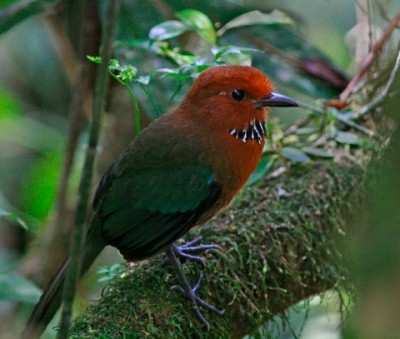
Rufous Headed Ground Roller (taken by C. Cohen).
Long – Tailed Ground Roller – Uratelornis chimaera
Endemic
After much searching, we finally say this in the spiny forest at Mora Mora, with a single bird on the 23rd, but the following morning, a pair put on a stunning show for us. Another highlight of our trip!!
Considered Vulnerable by Birdlife Int. (2000).
Long-Tailed Ground Roller in the Spiny Forest.
Cuckoo – Roller – Leptosomus discolor
Regional Endemic
Another fine species, with an amazing flight and call. Recorded on 9 dates but never more than 3 on a day.
Velvet Asity – Philepitta castanea
Endemic
A brilliant adult male sat close to the forest trail at Maromiza on the 4th. Two molting males were seen on the 18th at Ranomafana and 2 females at Perinet on the 30th.
Female Velvet Asity at Andasibe Forest Station, Perinet.
Male Velvet Asity at the Maromiza Forest.
Schlegel.s Asity – Philepitta schlegeli
Endemic
After many hours of searching, two were seen at Ampijoroa on the 12th and 13th, (three birds in total), including one fine adult male.
Poor Record shot of a distant male Schlegel's Asity at Anpijoroa.
Common Sunbird Asity – Neodrepanis coruscans
Endemic
Two seen feeding on flowering shrubs at Perinet on the 3rd, with 1 on the 17th, and 2 on the 19th at Ranomafana.
Madagascar Bush Lark - Mirafra hova
Endemic
Good numbers recorded and were seen on a total of 10 days with a maximum of 40 on the 20th.
Madagascar Bush-Lark at Zombitsy.
Mascarene Martin - Pheadina borbonica madagascariensis
Regional Endemic
Up to 6 recorded on a day on 10 dates. It proved to be the first species identified on our arrival at the airport.
Brown Throated Sand Martin – Riparia paludicola cowani
Recorded in small numbers on 8 dates, with a daily maximum of 30 on the 20th.
Madagascar Wagtail – Motacilla flaviventris
Endemic
Recorded in small numbers on 11 dates.
Madagascar Wagtail at Perinet.
Ashy Cuckoo-Shrike - Coracina cinerea
Regional Endemic
Recorded in small numbers on 11 dates chiefly in the forests.
Ashy Cuckoo-Shrike in the Zombitsy Forest.
Madagascar (Black) Bulbul – Hypsipetes madagascariensis
Regional Endemic
Fair numbers recorded virtually daily.
Madagascar Black Bulbul in the coastal dunes behind Anakao.
Long-billed Greebul - Phyllastrephus madagascariensis
Endemic
Up to 6 recorded on a day on 10 dates.
Long Billed Greenbul at Ranomafana National Park.
Spectacled Greenbul - Phyllastrephus zosterops
Endemic
Only recorded from Perinet and Ranomafana on a total of 6 days with a maximum of 8 at Perinet on the 3rd.
Appert’s Greenbul – Phyllastrephus apperti
Endemic
Four of these terrestrial greenbuls were seen well at Zombitsy Forest on the 21st. It is only known from two forest areas and Zombitsy Forest was being cleared at an alarming rate.
Considered Vulnerable by Birdlife Int. (2000).
Grey-Crowned Greenbul – Phyllastrephus cinereiceps
Endemic
One seen on the 18th, with 2 on the 19th at Ranomafana. When seen well, this species was quite distinctive.
Red Tailed Vanga – Calicalicus madagascariensis
Endemic
Up to 6 recorded on 8 dates.
Rufous Vanga – Schetba rufa
Endemic
One seen briefly in amongst a flock of birds at Anbanizana on the 7th, with 3 seen on the 11th and 1 on the 13th at Ampijoroa. This last bird sat the whole time perched above a pair of White Breasted Mesites. As the Mesites walked along on the forest floor, so did the Vanga move to another perch above them. This allowed me to follow the Mesites for some 100 yards, and when I lost them, I could quickly re-locate them by seeing where the Vanga was perched. No doubt, the Mesites were disturbing insects, which the Rufous Vanga could catch.
Male Rufous Vanga at Ampijoroa.
Hook Billed Vanga - Vanga curvirostris
Endemic
A striking specie. Only two singles were seen, the first at Perinet on the 3rd, and the second at Maromiza on the 4th.
Lafresnaye’s Vanga – Xenopirostris xenopirostris
Endemic
Two single males seen in the spiny forest at Mora Mora on the 23rd and 24th, may have related to the same individual.
Pollen’s Vanga – Xenopirostris polleni
Endemic
One seen briefly but well in a bird flock at Ranomafana on the 16th, and another probable there on the 17th but only seen at a distantace.
Van Dam’s Vanga – Xenopirostris damii
Endemic
Three seen on the 11th in the dry forest at Ampijoroa, one of which spent 10 minutes perched out in the open just a few yards from us.
Considered Endangered by Birdlife Int. (2000).
Female Van Dam's Vanga in the dry forest at Ampijoroa.
Sickle Billed Vanga – Falculea palliata
Endemic
Another superb specie. Eight seen on the 11th at Ampijoroa and on the 12th a flock of at least 20 flew over me calling loudly at this site. A single bird seen on the 22nd in the spiny forest at Mora Mora.
Sicklebill Vanga at Ampijoroa Forest Station.
White Headed Vanga – Artamella viridis
Endemic
Seen at Ampijoroa, with 3 on the 11th and 1 on the 12th. Two singles seen at Ranomafana on the 17th and the 19th, and 2 singles in the spiny forest at Mora Mora on the 22nd and 23rd.
Chabert’s Vanga – Leptopterus chabert
Endemic
The commonest vanga, with small numbers recorded on 19 dates with a daily maximum on 10 on the 4th.
Chaubert's Vanga at Ampijoroa Forest Station.
Blue Vanga – Cyanolanius madagascarinus
Endemic
This attractive vanga was recorded on 6 dates and proved to be commonest at Perinet with 12 on the 3rd and 4th, and 6 on the 30th. One seen at Ampijoroa on the 11th and 1 on the 15th with 4 on the 17th all from Ranomafana.
Blue Vanga at Perinet.
Helmet Vanga – Euryceros prevostii
Endemic
Three seen well in a bird flock in the pouring rain at Anbanizana on the 7th, made the trip to this area well worth while, even thou it rained virtually the whole time in this area. Probably the star bird of the trip!!
Considered Vulnerable by Birdlife Int. (2000).
Nuthatch Vanga - Hypositta corallirostris
Endemic
Seen at Perinet, with singles on the 3rd and 4th, with 3 on the 30th. They were all part of a mixed bird flock. Two at Anbanizana on the 7th again in a bird flock with Helmet Vangas.
Nuthatch Vanga taken directly into the light at Andasibe Forest Station.
Tylas Vanga – Tylas eduardi
Endemic
Singles seen on the 3rd and 4th at Perinet, with one on the 7th at Anbanizana in the bird flock, 2 on the 17th and 1 on the 18th at Ranomafana.
Littoral Rock Thrush – Monticola imerinus
Endemic
Six of these fine birds were located in 20 minutes in the sand dunes behind the coastal village of Anakao on the 27th.
Male Littoral Rock Thrush behind the coastal village of Anakao.
Female Littoral Rock Thrush behind the coastal village of Anakao.
Forest Rock Thrush - Monticola
Endemic
An adult male was seen at Perinet on the 4th and a second adult male was seen very well at Ranomafana on the 19th.
A distant male Forest Rock Thrush at Ranomafana National Park.
Benson's Rock Thrush - Monticola bensoni
Endemic
After two hours of searching, we located a male which responded to tape playback in a bushy gully at the Oasis on the 21st.
Madagascar Magpie- Robin - Copsychus albospecularis
Endemic
Recorded in small numbers on 20 dates. Two subspecies “inexpectata” and “pica” were identified.
Males Madagascar Magpie-Robins in the dry forests at Ampijoroa.
Common Stonechat - Saxicola torquata
Only recorded on 5 dates, with a maximum of 10 on the 20th.
White Throated Oxylabes – Oxylabes madagascariensis
Endemic
Another very difficult and skulking species to see. We finally found it at Ranomafana with 3 on the 16th, and 1 on the 19th, and a brief view of 1 at Perinet on the 30th.
Madagascar Yellowbrow (Yellow Browed Oxylabes) – Crossleyia xanthophrys
Endemic
One seen very close and well as it worked its way through an open area close to the forest trail at Ranomafana on the 16th.
Crossley’s Babbler – Mystacornis crossleyi
Endemic
A superb specie. A single bird spent some 10 minutes walking around us on the forest floor at Ranomafana on the 16th. It was raining. And I had left my camera behind. A second bird was seen briefly here on the 19th with others heard calling.
Brown Emutail – Dromaeocercus brunneus
Endemic
Another very skulking forest species, but luckily, they do re-act to tape playback. Our only sighting was of a single bird which eventually showed very well next to the trail at Maromiza on the 4th. We also heard one calling at Ranomafana.
Grey Emutail – Amphilais seebohmi
Endemic
Two seen well on the 15th and 1 on the 18th at the Vohiparara Marsh.
Grey Emutail at Vohiparara Marsh.
Madagascar Brush Warbler - Nesilla typical
Regional Endemic
Another very skulking specie, and many more were heard than seen. It was seen on a total of 11 days chiefly ones and twos but 4 were seen on the 22nd along the coastal strip at Mora Mora.
Madagascar Brush Warbler at Mora Mora.
Madagascar Swamp Warbler - Acrocephalus newtoni
Endemic
Three seen on the 4th 1 on the 5th, and 2 on the 30th, at Moramanga marsh, with 1 on the 20th at a marsh west of Vohiparara.
Thamnornis Warbler – Thamnornis chloropetoides
Endemic
An extremely skulking specie, and very difficult to see even when it was in a bush directly in front of us. Poor views obtained of 3 in the spiny forest at Mora Mora on the 23rd. Even with tape playback, they only showed briefly.
Rand’s Warbler – Randia pseudozosterops
Endemic
This small warbler is easy to overlook as it is usually seen in the tree canopy. We identified one on the 17th and 2 on the 18th at Ranomafana with 2 at Perinet on the 30th, but we must have missed others in the bird flocks.
Common Newtonia – Newtonia brunneicauda
Endemic
Seen in good numbers on 14 dates, and was one of the more commoner forest species.
Dark Newtonia – Newtonia amphichroa
Endemic
Another very skulking bird. Six re-acted to tape playback at Perinet on the 3rd and 1 seen well at Ranomafana on the 17th.
Archibold’s Newtonia – Newtonia archboldi
Endemic
After considerable searching without success, this specie quickly re-acted to tape playback in the spiny forest at Mora Mora on the 23rd.
Madagascar Cisticola – Cisticola cherina
Regional Endemic
Recorded on 6 dates but never more than 2 on a day.
Common Jery - Neomixis tenella
Endemic
I found this to be quite a confusing specie with several different looking subspecies, which proved troublesome when trying to pick out some of the other Jery species. It was one of the commonest flock birds, and we recorded it in fair numbers on 19 dates but we did not record it from the Northern area.
Common Jery at Ampijoroa.
Green Jery – Neomixis viridis
Endemic
It took us many days before we were satisfied that we had actually seen this specie, although no doubt we overlooked it. One was seen well on the 19th at Ranomafana with another single seen briefly at Perinet on the 30th.
Stripe-Throated Jery – Neomisis striatigula
Endemic
We finally got to grips with this specie, when 2 showed very well low down in the spiny forest at Mora Mora on the 23rd. We must have overlooked this at other sites.
Stripe Throated Jery in the spiny forest at Mora Mora.
Cryptic Warbler - Cryptosylvicola randrianasoloi
Endemic
This new warbler has recently been discovered in the rainforests at Perinet and Ranomafana. Luckily it has a very distinctive song and call, which draws attention to it. We had the song on tape, and obtained excellent views of one singing back to tape playback, with a second being seen later. Both sightings were at a Ranomafana stake-out on the 19th. This species was finally described in 1996.
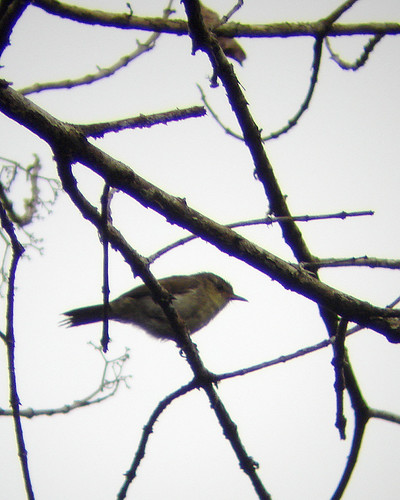
Cryptic Warbler (taken by Another observer).
Ward’s Flycatcher – Pseudobias wardi
Endemic
Seen at Perinet with 8 on the 3rd, 4 on the 4th, and 1 on the 30th. Also seen at Ranomafana with 1 on the 18th, and 2 on the 19th. A very attractive bird, but keeps mainly to the canopy and well out of my camera range.
.jpg)
Ward's Flycatcher at Perinet (taken by D. Cooper).
Madagascar Paradise Flycatcher – Terpsiphone mutata
Regional Endemic
Both white and rufous morphs seen of this lovely bird. Recorded on 13 dates with a daily maximum of 10 on the 3rd at Perinet. Superb!!
(Difficult getting all the tail in the photograph)
Souimanga Sunbird - Neactarinia souimanga
Regional Endemic
Common, and recorded in good numbers on 20 dates
Souimanga Sunbird at La Mangrove.
Long-Billed Green Sunbird – Nectarinia notata
Regional Endemic
Not as common as the previous specie, but still seen on 11 dates with up to 10 on a day.
Long-Billed Green Sunbird at the Andasibe Forest Reserve.
Madagascar White-eye – Zosterops maderaspatana
Regional Endemic
Seen on 11 dates with a daily maximum of 50 on the 4th.
Madagascar Mannikin – Lonchura nana
Endemic
Only small numbers seen on 6 dates with 4 seen at Mora Mora on the 22nd and 4 at Perinet on the 30th.
Nelicourvi Weaver – Ploceus nelicourvi
Endemic
This attractive forest weaver was seen in small numbers on 7 dates, with a pair nest-building at Anbanizana.
Sakalava Weaver – Ploceus sakalava
Endemic
Good numbers were recorded in drier areas always around habitation on 9 dates. All birds were in non-breeding plumage and there was a colony with nests hanging from trees in the village at Ampijoroa.
Sakalava Weaver at Mora Mora.
Madagascar Red Fody - Foudia madagascariensis
Endemic
Common and widespread. Seen on 15 dates including a roosting flock of 600 birds at Anbanizana. Most were in non-breeding plumage and one was also seen at Seychelles Airport on the 2nd.
Madagascar Red Fody in non-breeding plumage at Maronasetra Lodge.
Madagascar Red Fodies at a drinking tap at Mora Mora.
Forest Fody – Foudia omissa
Endemic
A male seen well at Maromiza on the 4th, with 1 on the 15th at Vohiparara and 2 at Perinet on the 30th, were the only ones positively identified.
Common Myna – Acridotheres tristis
Common in scattered areas usually close to habitation. Seen on 7 dates with a daily maximum of 50 on the 5th.
Madagascar Starling – Hartlaubius auratus
Endemic
Only seen on 2 days. Six seen in flight over Ranomafana with 3 perched up at Perinet on the 30th.
Crested Drongo – Dicrurus forficatus
Regional Endemic
Common, and widespread, and recorded on 24 dates.
Crested Drongo at Ampijoroa Forest Station.
Pied Crow - Corvus albus
Common, and widespread, and recorded on 13 dates.
Pied Crow at Maronasetra Lodge.
LEMURS.
Brown Lemur
Two seen at Perinet with 6 seen at Ampijoroa on the 11th and 4 on the 12th.
Brown Lemurs at Andasibe Forest Station.
Grey Gentle Lemur
Two seen at Perinet on the 3rd, 4th and 30th, with 1 on the 16th and 2 on the 17th at Ranomafana.
Grey Gentle Lemur at Ranomafana National Park.
Avahis or Woolly Lemur
Four seen at Perinet on the 3rd.
Avahis at Andasibe Forest Station.
Indri
One seen asleep at Perinet on the 3rd.

Indri Lemur in Andasibe (by Another observer).
Fat Tailed Dwarf Lemur at Ampijoroa.
Mongoose Lemur
Two seen on the 13th at Ampijoroa.
Verreaux’s Sifaka
Five seen at Ampijoroa on the 11th with 2 there on the 12th.
Verreaux's Sifakas at Ampijoroa Forest Station.
Diademed Sifaka
Two singles seen at Ranomafana on the 17th and 18th.
Red Bellied Lemur
Two seen at Ranomafana on the 17th, 18th and 19th.
Red Breasted Lemur at Ranomafana.
Great Bamboo Lemur
This very rare lemur, once thought to be extinct was seen at Ranomafana on the 18th when a single was seen.
Mouse Lemur
A single came out at dusk at a stakeout at Ranomafana on the 19th.
Lesser Mouse Lemur at dusk at Ranomafana.
Ring Tailed Lemur
A single was present around the hotel at Mora Mora on several days.
.jpg)
Ring Tailed Lemur (Taken by D. Cooper).

